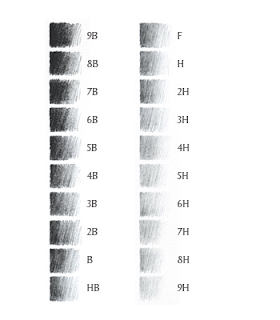Pencils?! How boring...right? Wrong!
Pencils and crayons seem to be the two items you can't get through childhood without. And pencils are ever present through the education system. But as an art tool, they are often relegated to a preliminary status. You draw what you need, erase the lines, and complete the image in another fashion.
Well, today we're going to look at how to shade with pencils. I was partly inspired by a book I had never seen before, Are You My Mother? by P.D. Eastman. (I have to say, I don't remember a lot of the "kids" books from my own childhood. My mother jokes that I've been 30 since kindergarten. Kids books never interested me then but they do now....!)
The illustrations look like they're pencil drawings, fully rendered, then colored in later on. The pencil shading is an integral part of the image and that's what I want to talk about today.
First, let's talk about different types of pencils. Yes, there are pencils other than your standard #2!! For a very thorough overview of pencils, see the Wikipedia article here.
Mechanical pencils:
These are a regular part of my arsenal. I use a regular old Bic but you can get mechanical pencil kits with interchangeable leads in varying hardnesses. I like these for everyday sketching and for travel. The lead width is pretty consistent and a nice hardness. The only real drawback is that I tend to press a little hard and etch into my paper.
Artist's drawing pencils:
These are also a regular part of my creative process. As you can see, these pencils are short for lots of use!
I use Derwent pencils primarily. There are other great brands out there, but I've been using these for nearly 20 years and love them. The are easy to sharpen and the wood is a high enough quality that it doesn't split when sharpened. Always buy the best supplies you can!
Pencils come in different grades, from a 9H to a 9B. The numbers indicate level of hardness, with higher numbers indicating a higher degree. Letters indicate softness or hardness. A 9H is a very hard pencil and a 9B is a very soft pencil.
But that chart has an F on it?! That isn't an H or a B! F is the approximate middle hardness, neither hard nor soft. I tend to work in the middle of the range. I have a few very soft pencils for very dark colors (6B-9B) and a few very hard pencils for light, precise lines (6H-9H), but most of the pencils I use fall in the 3B-3H levels. You can buy these pencils individually or in sets.
Water soluble artist's pencils:
These follow the same rules as the artist's pencils but they are water soluble. These pencils can be used like ordinary pencils but you can also brush over them with water to create washes.
And that device under the two pencils is a pencil extender. Get one! Stubby little pencils become useable again with this thingie.
Sharpeners and Erasers:
A good sharpener and eraser is just as important as a good pencil. I have a three-sided pencil sharpener. One side sharpens the whole point, one side sharpens just the very tip, and one side sharpens larger pencils. Some people also use a pen knife or sandpaper to shape their pencils. As for erasers, I love my kneaded eraser (far right of image). It's soft, doesn't crumble, erases well, and is great for detail work. The art gum eraser (center) is an eraser I like to have but rarely use. It crumbles a lot and doesn't do great on detail work. But it erases very completely and works well for larger areas. The vinyl eraser (left) is a lot like the art gum eraser but holds its shape a little better.
Don't use the standard pink eraser. It's messy and barely erases.
Paper
The papers you use are important too. For sketching, I use a Strathmore sketchbook. I like a little texture (or tooth, as its called). Some people prefer smooth papers or rough papers. Try several out and see which markings you prefer. For pencil drawings that I plan to leave as-is, I like a hot press watercolor paper. It's a semi-smooth texture that erases nicely and holds the marks well.
So that's just about everything I know about pencils! The lesson for Monday will be a doll shaded using pencils. I want to discuss types of shading (side of the pencil, hatching, etc) and then how to color your pencil drawing, should you choose to go that route.



That is funny that you used a pic from Are you my Mother? I had that book in my head today, and was asking my girls "are you my mother?". They seemed quite lost, and apparently do not remember me reading that book to them when they were much younger.
ReplyDeleteThat is funny! It's a new-to-me book and I'm not even sure if we've read it to the boys yet. I wish I had that graphic style but I always get a little carried away!
ReplyDelete